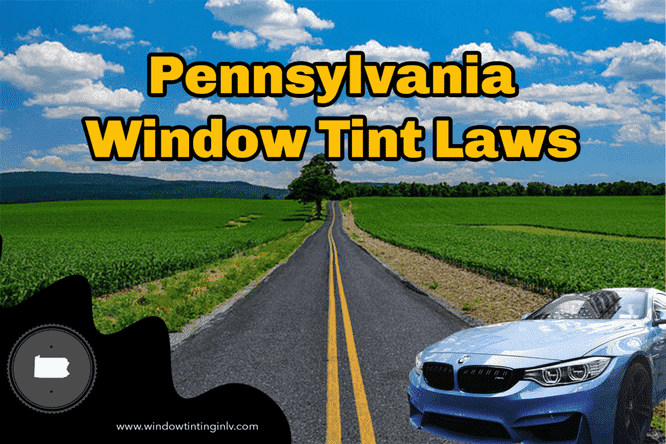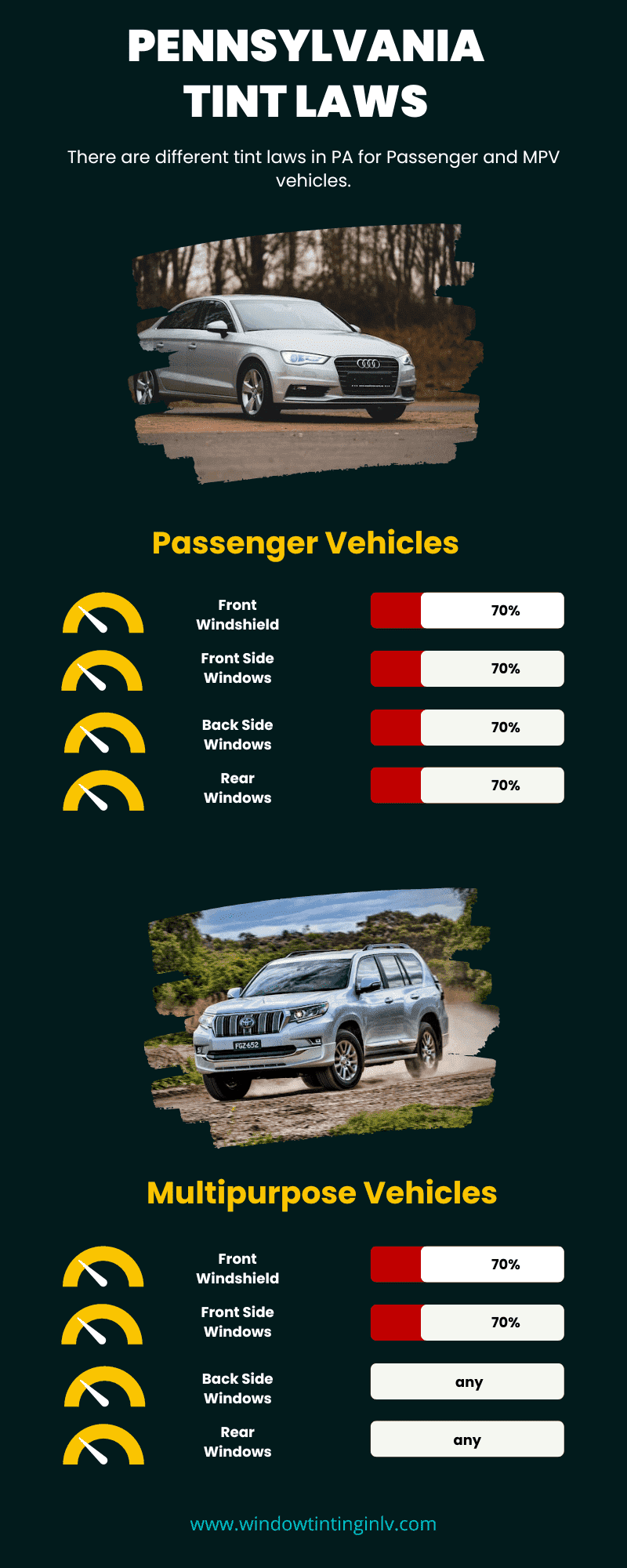
Disclaimer: As an Amazon Associate I earn from qualifying purchases.
Tinting your car windows is a quick way to add that luxurious touch to your vehicle. But it’s not just cool for aesthetic purposes.
Window tint also blocks sunlight, shielding your skin and eyes from ultraviolet rays and protecting your interior from discoloration due to constant sunlight exposure.
Tint can also protect you and your vehicle’s interior from the heat that spreads when you’re parked in the sun for a while or on long sunny trips.
Besides, who doesn’t like some extra privacy in their car away from the gazes of curious strangers?
But before you rush to your nearest film manufacturer for the darkest tint film they have, you should be familiar with your local tint laws.
In this article, we’ll review the Pennsylvania window tinting laws. So read on to avoid getting a hefty fine and an awkward talk with the police.
The Current Pennsylvania Tint Laws in a Nutshell
The legal window tint in PA is 70% or more VLT in most cases. However, there are some exceptions.
For example, you can use whatever darkness you want on the top three inches of your windshield, which is a great way to block direct sunlight from reaching your eyes while driving.
Similarly, there’s no darkest legal tint in PA regarding rear side windows and rear windows of multi-purpose vehicles, such as SUVs, vans, and other non-passenger cars.
The law also prohibits metallic tint films because of their reflectiveness, which is a safety and security hazard. Tint films with mirrored reflections are illegal because they can dazzle or distract other motorists.
Lastly, you can be allowed a lower legal VLT as part of a medical exemption if the Medical Advisory Board of the DMV permits it.
Visible Light Transmission Explained
Visible light transmission (VLT) is the amount of light that can pass through your windows. Lower VLT values mean less light passes, which is a sign of a darker tint.
Legal Tint in PA
In 1996, the Pennsylvania Department of Transportation adopted laws regarding window tints for the first time, eliminating the need to inspect window tints manually.
Nowadays, the restrictions on tinting car windows are defined in the Pennsylvania Code Title 75 Section 4524, titled “Vehicles.” In addition, the PA window tint law is specifically mentioned in subchapter (e), which discusses sun-screening materials like window tint.
So here are the minimum VLT values approved for passenger and multi-purpose vehicles in Pennsylvania.
For Passenger Vehicles:
- Windshield: 70%, but you can have any tint darkness on the top three inches of your windshield
- Front side windows: 70%
- Rear side windows: 70%
- Rear window: 70%, except on cars made before 1998, which can have down to VESC-20 tint
For reference, VESC stands for Vehicle Equipment Safety Commission, and the 20 refers to the 20% VLT permitted for the rear windows of pre-1998 passenger cars.
If you’re using a VESC-20 tint, you must have a sticker label permanently installed between the tint and your window with the name of your tint manufacturer or a registration number. Also, the label must state that it complies with VESC-20.
For Multi-Purpose Vehicles:
- Windshield: 70%, but you can have any tint darkness on the top three inches of your windshield
- Front side windows: 70%
- Rear side windows: No limit; any tint darkness is allowed
- Rear window: No limit; any tint darkness is allowed
The Pennsylvania Department of Transportation defines multi-purpose passenger vehicles as vehicles built on a truck chassis. This includes many popular SUV models, like the Toyota Sequoia, Mercedes G-Class, Jeep Wrangler, and Lincoln Navigator.
Of course, the definition encompasses all trucks, medium or large, by default. But other big vehicles like buses are also included.
And to avoid confusion among people whose vehicles aren’t specifically named, all other vehicles also have the same regulations as multi-purpose vehicles. This covers things like RVs.

Window Tint Reflection in PA
Tinting your windows will naturally make them reflect more light rather than let it pass into your interior. And that’s fine as long as the reflections aren’t mirrored or metallic.
Metallic tint films are often more expensive because of their metallic particles, which give them stronger shielding and reflecting abilities. However, they can also hinder your car’s radio signals and cell reception.
And since metallic tints can produce stronger reflections, they’re a safety hazard to other drivers because your windows could reflect light into their vision.
As for mirrored reflections, they’re illegal because they can distract other drivers, especially if they’re behind you.
Other PA Tint Laws
Besides the window tint law in Pennsylvania, there are other implications you should know before tinting your car windows.
While you’re allowed at least 70% VLT on your rear windows on passenger cars and no restrictions on multi-purpose vehicles, you must use dual side mirrors if you decide to tint them. That’s because tinted rear windows can hinder your direct vision of cars behind you.
You must also apply a sticker identifying your tint and confirming that it’s legal.
Medical Exemptions to Pennsylvania Tint Law
If you have a medical condition that requires more tint, you can contact the DMV’s Medical Advisory Board to go under the darkest legal tint in PA.
Of course, you’ll need evidence that your medical condition requires a lower VLT. A letter from your doctor with your info and details about your condition should be enough.
Medical exemptions typically allow you to use only colorless window tints with a lower VLT.
You can fill out the PA window tint exemption form here, print it, and submit it to the DMV’s medical board.
Final Thoughts on Pennsylvania Tint Laws
Pennsylvania’s tint laws may sound harsh at times, but they’re here for everyone’s safety. After all, tint can easily be exploited by people with ill will, and other types of tint can distract other motorists.
Besides, you can still freely enjoy a good tint of darkness while complying with all the regulations. You can even choose any tint color since Pennsylvania doesn’t have laws against them.
References
https://www.legis.state.pa.us/WU01/LI/LI/CT/HTM/75/00.045.024.000..HTM
https://www.uslegalforms.com/form-library/100730-pa-window-tint-exemption-form-2020
https://iwfa.com/wp-content/uploads/2021/12/State-Law-chart-2021.pdf
Check Out Other States Window Tint Laws:
Window Tint Law In California
Texas Window Tint Laws
Nevada Window tinting Laws
Window Tint Laws in Florida
Window Tint Laws in Ohio
Window Tint Law in Virginia
North Carolina Window Tint Laws
Window tint Law In Georgia
Michigan Window Tint Laws